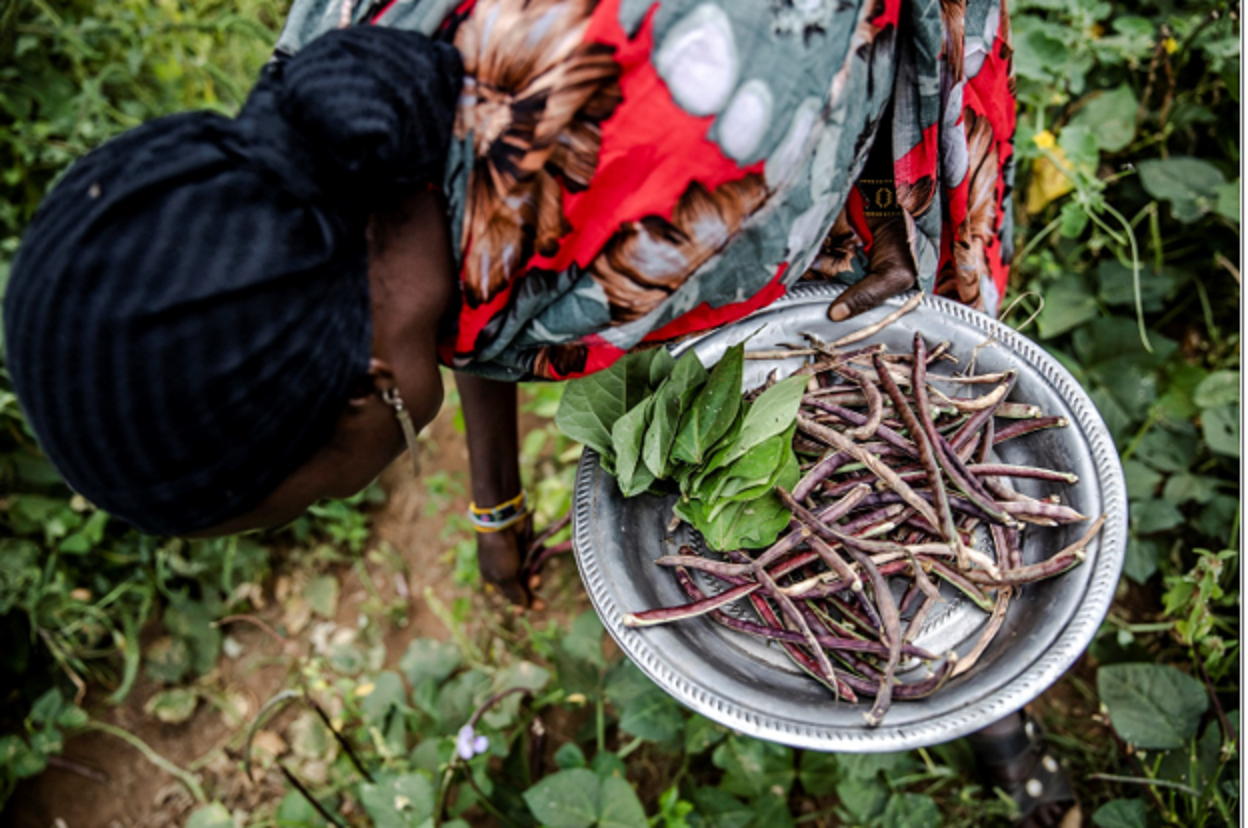6 July 2021, Uran Ward, Moyale, Marsabit County, Kenya - Amina Guyo works harvesting cowpeas and cowpeas leaves to prepare the main meal of the day at her piece of land next to her house in Uran ward, Moyale, Kenya.
Amina is one of the beneficiaries under the Desert Locust post recovery project (©FAO/Luis Tato)
The recent 26th Conference of the Parties to the United Nations Framework Convention on Climate Change (COP26) resulted in several widely hailed agreements between member states including the Glasgow Leaders’ Declaration on Forests. Signed by 141 nations, this declaration emphasizes the role of forests in enabling the world to meet its development, ecosystem and climate change goals. It recognizes the importance of indigenous people and local communities (IPLCs) as forest guardians and critical partners in addressing climate change. More specifically, the declaration calls on members to “reduce vulnerability and enhance rural livelihoods…while recognizing the rights of Indigenous Peoples, as well as local communities, in accordance with relevant national legislation and international instruments.” Shortly thereafter, the COP26 IPLC Forest Tenure Joint Donor Statement was announced in which governments and donors pledged a remarkable USD 1.7 billion towards advancing support for IPLC tenure rights and forest guardianship to be implemented between 2021 and 2025. This amount is regarded as largely additional and beyond regular programming budgets.
These political and financial commitments signify a broader recognition that IPLCs are at the heart of protecting forests, with secure tenure rights as a critically important enabling condition, a finding that is backed up by numerous scientific studies. The research and advocacy efforts of many groups, including the Global Alliance of Territorial Communities, Rights and Resources Initiative, Forest Trends, Rainforest Foundation Norway, the Tenure Facility, Center for International Forest Research (CIFOR), Climate and Land Use Alliance (CLUA), among others, have helped turn the tide of opinion and garner a critical mass of support for these landmark Declarations. The UN-REDD Programme has also contributed to global advocacy efforts by promoting secure tenure rights for IPLCs as a key enabling condition for successful implementation of REDD+.
Delivering on these COP26 commitments presents both opportunities and challenges. Throughout the world, a great deal of work is still needed to secure the tenure rights of IPLCs. Many countries do not have the legal frameworks to fully recognize customarily held lands and indigenous ancestral domains, and when these frameworks do exist, they are often not enforced or else implemented inefficiently. According to the Tenure Facility, only 10 percent of IPLC land is held under formal legal ownership, and an additional 8 percent has some degree of government-recognized management rights. Most disturbingly, in many countries, IPLCs that fight for their tenure rights are persecuted and sometimes even executed.
With the COP26 pledges, secure tenure rights for IPLCs have the potential to be rapidly expanded. There is also an opportunity to secure the tenure rights of women and other marginalized groups within Indigenous and local communities. In many traditional cultures, women’s tenure rights have been ignored, increasing women’s vulnerability. According to the World Economic Forum, women own less than 20 percent of the world’s land. With secure tenure rights also comes the opportunity for IPLCs to engage in and benefit from forest carbon markets, climate finance and other land-based investments. However, there are important gaps in terms of the institutions and capacities to mobilize and to channel these resources to the sub-national and local levels and to use them effectively. New funding models that are adapted to meet local requirements and capacities are needed. Intermediary mechanisms such as the Tenure Facility, the Peoples Forests Partnership and CLARIFI, can play important interim roles in the delivery of finance and institutional strengthening for securing tenure rights. Furthermore, the final goal should be to ensure more direct transfers to the local level that will maximize benefits. Governments have a key role to play in strengthening and enforcing legal frameworks for individual and/or collective tenure rights recognition, while NGOs and other actors can contribute to strengthening local institutions and accountability mechanisms, including enhanced transparency and monitoring systems.
The 2012 Voluntary Guidelines on the Responsible Governance of Tenure remain as valid and useful as ever to inform and guide expanded tenure rights work, instilling principles of responsible practice. The UN-REDD Programme will endeavor to support all of these efforts through its work with governments and multiple stakeholders to improve national land and forest tenure systems. While the COP26 commitments are significant and laudatory, they should mark the beginning of a new momentum.
Key next steps post COP26:
- Assess gaps and further strengthen legal frameworks that promote IPLC tenure rights recognition and enforce related laws and regulations, with an emphasis on faster and more efficient processing of claims;
- Expand on-the-ground work to demarcate IPLC lands and submit claims for legal recognition using a gender responsive approach and applying appropriate technology;
- Support climate funding models and national capacity development to optimize channeling of funds to the local level and facilitate IPLC’s access;
- Increase transparency and accountability through a global database on financial flows to IPLCs, with annual reporting to the Conference of the Parties; and,
- Under the principles of Free Prior and Informed Consent (FPIC), support IPLCs with recognized tenure rights to access carbon finance on their own terms and pursue other complementary sustainable financial/livelihood opportunities.
Other resources:
- Collective tenure rights: Realizing the potential for REDD+ and sustainable development. Technical Paper
- Collective tenure rights: Realizing the potential for REDD+ and sustainable development. Information brief
- Forest governance by indigenous and tribal peoples. An opportunity for climate action in Latin America and the Caribbean
- Voluntary Guidelines on the Responsible Governance of tenure of Land, Fisheries and Forests in the Context of National Food Security
- Making Secured Collective Tenure Rights a Reality in Nepal, Peru and Tanzania
Author
Amanda Bradley
REDD+ Tenure Specialist
REDD+ Team, FAO Forestry Division
amanda.bradley@fao.org
Contributions from Amy Duchelle, Maria Ruiz-Villar, Minoarivelo Randrianarison

